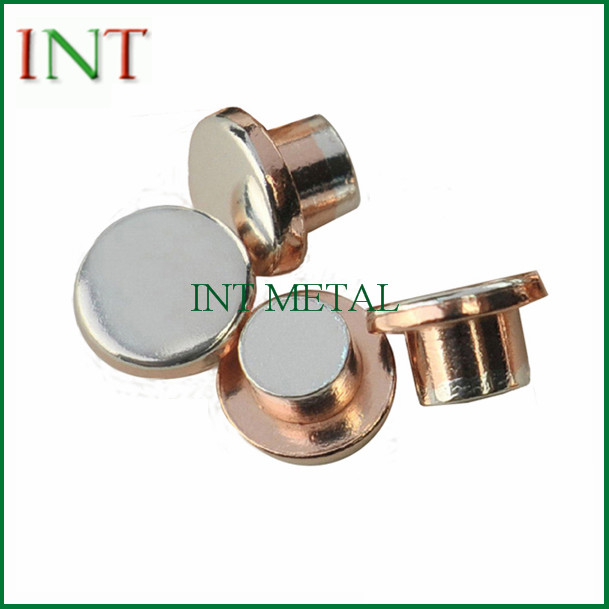Understanding Contact Rivets: Applications, Benefits, and Key Considerations
2025-02-07
Contact rivets are essential components in electrical and electronic applications, providing reliable connections in switches, relays, circuit breakers, and various other devices. These specialized rivets ensure excellent electrical conductivity, durability, and resistance to wear, making them a preferred choice in industries such as automotive, aerospace, and consumer electronics.
In this article, we will explore the types, applications, advantages, and key considerations when selecting contact rivets for different electrical applications.
What Are Contact Rivets
Contact rivets are small metal fasteners with conductive surfaces that facilitate electrical connections in various devices. They are designed to withstand high current loads and repeated operations, ensuring a stable and long-lasting electrical circuit.
Unlike standard rivets, which are primarily used for mechanical fastening, contact rivets are optimized for low electrical resistance and high conductivity, making them crucial for electrical contact applications.
Types of Contact Rivets
There are several types of contact rivets, each designed for specific applications. The most common types include:
1. Solid Contact Rivets
- Made entirely of a conductive material such as silver, copper, or their alloys.
- Used in low-voltage applications where high conductivity is essential.
2. Bimetal Contact Rivets
- Consist of a conductive layer bonded to a base metal.
- Provide a cost-effective solution by using expensive conductive materials only on the contact surface.
- Commonly used in switches, relays, and circuit breakers.
3. Trimetal Contact Rivets
- Feature a three-layer structure with a conductive material on the outer surfaces and a base metal core.
- Offer enhanced performance, better wear resistance, and lower material costs compared to solid contact rivets.
- Frequently used in high-current and high-temperature environments.
Applications of Contact Rivets
Contact rivets are widely used in electrical and electronic components due to their ability to ensure reliable current flow. Some key applications include:
1. Electrical Switches
- Used in household and industrial switches for making and breaking electrical connections.
- Ensure low resistance and high durability.
2. Relays and Contactors
- Essential in control circuits where frequent opening and closing occur.
- Reduce wear and energy loss in switching applications.
3. Circuit Breakers
- Protect electrical circuits by interrupting excessive current flow.
- Require rivets with high conductivity and thermal resistance.
4. Automotive Electrical Systems
- Found in ignition systems, power window controls, and lighting circuits.
- Ensure long-term reliability in harsh environments.
5. Aerospace and Defense Equipment
- Used in aircraft control systems, radar units, and navigation equipment.
- Require high-precision contact rivets with superior durability.
6. Consumer Electronics
- Found in devices such as remote controls, power adapters, and appliances.
- Help maintain consistent electrical performance in everyday gadgets.
Benefits of Using Contact Rivets
Using contact rivets in electrical applications offers several advantages, including:
1. High Electrical Conductivity
- Ensures efficient current flow with minimal energy loss.
2. Excellent Wear Resistance
- Withstands repeated electrical switching without significant degradation.
3. Corrosion Resistance
- Prevents oxidation and material breakdown in humid or corrosive environments.
4. Cost-Effective Solutions
- Bimetal and trimetal rivets provide high performance while reducing material costs.
5. Easy Manufacturing and Installation
- Can be integrated seamlessly into mass production processes for electrical components.
Key Factors to Consider When Choosing Contact Rivets
When selecting contact rivets for electrical applications, consider the following factors:
1. Material Selection
- Silver-based alloys offer the highest conductivity but can be expensive.
- Copper-based rivets provide a good balance between conductivity and cost.
- Tungsten or nickel coatings enhance wear resistance in high-voltage applications.
2. Current and Voltage Requirements
- High-current applications require rivets with low contact resistance.
- Voltage fluctuations may demand rivets with high thermal stability.
3. Mechanical Strength
- Ensure the rivets can withstand mechanical stress and vibration in their operating environment.
4. Environmental Conditions
- Consider exposure to moisture, temperature extremes, and chemical exposure.
- Corrosion-resistant coatings or alloy combinations may be necessary.
5. Manufacturing and Assembly Requirements
- Evaluate riveting methods such as cold forming or hot forming.
- Ensure compatibility with automated assembly lines for mass production.
Conclusion
Contact rivets play a vital role in electrical connections, offering durability, conductivity, and cost efficiency. Whether used in switches, relays, circuit breakers, or automotive systems, choosing the right contact rivet ensures reliable and long-lasting performance.
By understanding the types, applications, and selection factors, manufacturers and engineers can optimize their electrical components for efficiency and durability, making contact rivets an essential part of modern electrical systems.



